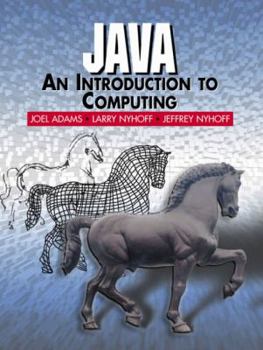Java: An Introduction to Computing
Introduces the key ideas behind computing with Java and object-oriented programming in an intuitive way. Text based programming and graphical/internet programming are both taught. Also included is an... This description may be from another edition of this product.
Format:Paperback
Language:English
ISBN:0130142514
ISBN13:9780130142511
Release Date:January 2001
Publisher:Prentice Hall
Length:945 Pages
Weight:3.15 lbs.
Dimensions:1.5" x 7.1" x 9.1"
Related Subjects
Beginner's Guides Computer Science Computers Computers & Technology Education & Reference Graphics & Multimedia Graphics & Visualization Introductory & Beginning Java Languages & Tools Mathematics Microsoft Object-Oriented Design Programming Programming Languages Science & Math Software Design, Testing & EngineeringCustomer Reviews
3 ratings
Formerly one of the best intro books out there
Published by Thriftbooks.com User , 17 years ago
Note. The publisher has chosen not to revise this text, and it lacks a number of useful recent Java features. Also, the publisher now only issues the text using B & W PoD technology and not the multi-color offset process in which it was originally published. I have been successfully using this book for several years to teach Introduction to Computer Science. One of the things that I like about this title is that it presents a clear and effective design strategy. Another, feature is an excellent set of companion laboratory exercises. Not only have I been happy with this book as a college text, one of my students went on to base his own high-school course on the course based on this text which he took from me. In addition to a lucid presentation of introductory programming, this book incorporates a number of essays on topics in computer science including complexity, ethics, and artificial intelligence. The accompanying ancilliary materials are designed to work on a variety of platforms. An instructor needs to keep this in mind and set up a functional laboratory environment and clearly explain to students how to correctly install the software package if students are to use the ancilliaries on their own computers.
Good As a Review
Published by Thriftbooks.com User , 22 years ago
I have faced with this book in the Fall 2001 computer science course "Data Structures and Algorithms". As a novice to Java, I think this book does not cover enough introductory issues such as how importing of the libraries work, what are the installation instruction of JDK. They do not even give us any clue how to set up ann lib without using JBuilder. The documentation on the CD-ROM is for JBuilder users only. But overall book structure is very good.
A class book that achieves its object
Published by Thriftbooks.com User , 22 years ago
I am planning to teach Java to biosciences graduates as a first language for the first time, having used a subset of C++ up to now. There are a lot of books on Java, but not so many that are suitable for mature beginners. The question is, am I about to endorse this as the course recommended text? The answer is yes - it's pretty much the book I wish I had written.The author of a book like this has to face some difficult decisions: how soon do I talk about objects and classes? Do I use applets or applications? If applications, how to avoid making all the methods in my main class static? Do I use simplified I/O classes? And so on. I think Adams et al have made the right decisions. Object-centred design is brought in right at the beginning and provides a framework for translating from the problem domain to the program domain. There aren't any sudden leaps in complexity - GUI programs are introduced alongside console applications and fully-fledged OOP appears about two-thirds of the way in. Examples are interesting and there are some good suggestions on programming practice like including preconditions in method documentation where applicable.Overall the book is well-presented and good value (you get a CD and there is a very useful web site). I like the sections on topics like ethics and AI, and the treatment of data structures. The quizzes are very good too. There are just a few niggles: easy I/O classes are provided on the CD, but I couldn't find advice on where to put these in order to run the console examples which all contain an import statement. I'm not totally convinced about introducing static methods as the norm, and I don't see the point of a list of the names of all the classes in Java SE 1.3 - a glossary would be more helpful. But these are minor and can be sorted out in later editions and through the web site - as an introduction to programming and computing the book represents a worthwhile addition to the literature and I (and I hope my students) will be very grateful for it.





